
Sun angle and sun path
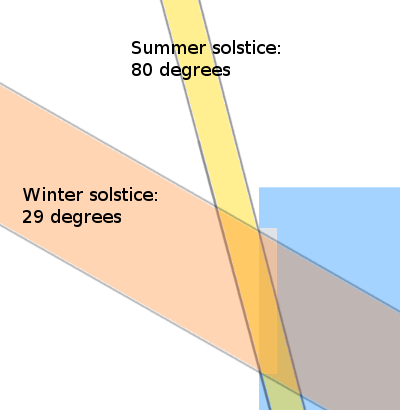 Yesterday I wrote that our
new porches tempt me and Mark to spend more time relaxing outdoors than we used to. As a
result, we've been paying more attention to the natural world, and,
after a couple of weeks, I made a shocking dicovery. The summer
sun rises in a totally different
spot than the winter sun does!
Yesterday I wrote that our
new porches tempt me and Mark to spend more time relaxing outdoors than we used to. As a
result, we've been paying more attention to the natural world, and,
after a couple of weeks, I made a shocking dicovery. The summer
sun rises in a totally different
spot than the winter sun does!
Yes, we technically
already took advantage of this fact when we planned
our south-facing trailer windows to capture winter sun without roasting
us in the summer. And if you'd asked me a year ago, I could have
told
you that the sun is lower in the sky in the winter than in the summer.
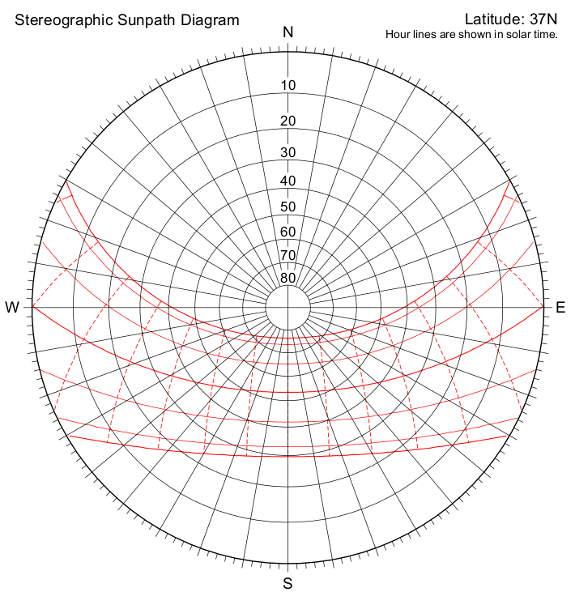
But I didn't realize
that the sun being higher in the summer sky means that it rises over
the barn instead of over the hill like it does in the winter!
This tidbit of data makes our budding passive solar heating and cooling
systems a bit more complex.
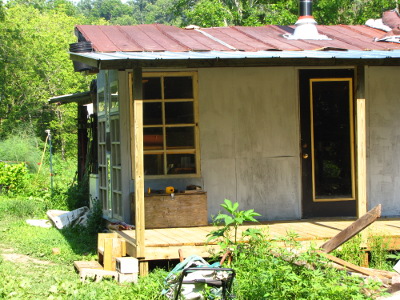 Notice how our new porch shades the East Wing from
the morning sun. I was a bit concerned that we'd be losing some
much-needed winter solar gain, but overlaying the sunpath diagram with
a map of our property shows that the sun has moved so far south in the
sky by late fall that it barely hits the side of the east wing at all.
Notice how our new porch shades the East Wing from
the morning sun. I was a bit concerned that we'd be losing some
much-needed winter solar gain, but overlaying the sunpath diagram with
a map of our property shows that the sun has moved so far south in the
sky by late fall that it barely hits the side of the east wing at all.
By the same reckoning,
we could probably block some of the scorching late afternoon sun on the
west side of our trailer without impacting winter solar heat gain as
well. I'm still 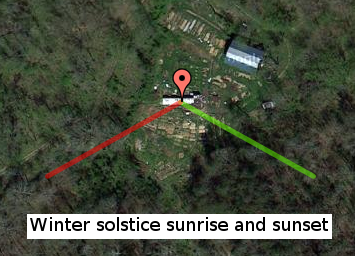 wrapping my head around the
fact that the sun doesn't rise in the east and set in the west, though,
so I think I'm going to observe a little longer before I make any
drastic decisions for that area.
wrapping my head around the
fact that the sun doesn't rise in the east and set in the west, though,
so I think I'm going to observe a little longer before I make any
drastic decisions for that area.
If you want to play with
sun patterns in your own neck of the woods, there are lots of good
resources on the web. This website allows you to
calculate the sun angle at your latitude (but you'll have to draw the
elevation mockup yourself) and this
website has downloadable sunpath diagrams, like the second image in
this post. Finally, this website allows
you to plot sunrise and sunset locations overlaying an aerial photo of
your property for any day of the year.
Or you can just build a
porch and watch the world unfold around you.
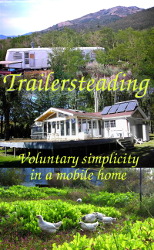
Edited to add:
Read more about passive
solar design in Trailersteading, which is now available for
$1.99 on Amazon. I hope you enjoy reading it as much as I enjoyed
writing it!
Want more in-depth information? Browse through our books.
Or explore more posts by date or by subject.
About us: Anna Hess and Mark Hamilton spent over a decade living self-sufficiently in the mountains of Virginia before moving north to start over from scratch in the foothills of Ohio. They've experimented with permaculture, no-till gardening, trailersteading, home-based microbusinesses and much more, writing about their adventures in both blogs and books.
Want to be notified when new comments are posted on this page? Click on the RSS button after you add a comment to subscribe to the comment feed, or simply check the box beside "email replies to me" while writing your comment.

I find it easier to visualise this in 3D. This is were a bit of knowledge from astronomy comes in handy. Take a globe with a tilted axis, and draw lines on it by rotating the globe on its axis with a marker held horizontally. Do this in different orientaties w.r.t. the rotation axis of the earth, and you'll see that the projection of the sun on earth is a circle of a sphere on different latitudes.
Public observatories and science museums generally have displays that describe the ecliptic versus the celestial equator. Another insightful tool is a good orrery.
BTW, the sun does rise in the east and set in the west, but only on the equinoxes.
A very powerful tool for determining where shadows will fall on a structure is Google SketchUp. You can get some rough dimensions (the more accurate the better) and model things quickly and then change the time of day as well as time of year, and it will update automatically so you can see where the shadows fall with different length overhangs etc. A 3D visualization is a very helpful tool.
It would be nice to be able to do the same thing with trees on a property but it would be very difficult and time consuming to model.
Roland --- You're right on track --- seasons have always seemed like a mystery to me. No matter how hard I try to wrap my head around the tilt of the earth, I can't seem to make that 3D visualization work. Sounds like I'll have to track down one of those displays in a museum and see it for myself.
I did learn about the ecliptic just this past winter, which was handy. And I did finally realize while making this post that the equinoxes would be the time when the sun rises in the east. Yes, I'm slow...
Brian --- I've been tempted by Google Sketchup many times, but they don't support Linux and I'm never tempted enough to boot to the evil Windows side of my computer. Plus, I suspect it would be tough to really make shadows for our farm since we're encircled by hills and trees of different heights. Maybe someday I'll head to Windows and give it a try....
Heres a video of how easy it is to show where shadows are cast different times of the day and of the year.
http://www.architectionary.com/TutorialsShadows
It wouldn't take long to do a model of your house and see how different size/height/location awnings or porches would effect the shading in different seasons.
I don't think I would use it to model all the trees on your property but for awnings and overhangs I think it would be useful.
If you ever reboot give it a try.
I did sunpaths for my property last year as part of my permaculture design certificate, and can confirm that the theory did match what actually happened through the seasons :-).
I just bought a trail camera (I think you have one, Anna?) and it has a feature to take timed photos throughout the day. Next winter and summer solstice, I'm going to set it up in my yard and photograph a day's worth of shadows, so I can get a really good idea of where they actually fall through the day.
Out of interest, Google recently sold SketchUp to Trimble. It works on Mac too, so there is a good non-Windows option :-).
Just wanted to let Anna know that there is as linux based program to help visualise the earth and sun, moon movements in relation to each other. It is called Openstereo and here is their web link http://openstereo.sourceforge.net/.
Good work on your site its great to seeing people become empowered harmoniously with our environment as much as possible. As a side note I have been using Linux Mint as my operating system due to is non commercial purpose i.e. it costs nothing. I did this 5 years ago to support sustainable practices. Ill tell you from my own experience its way more reliable and simple to use than Windows ever was.
I know this is off topic somewhat but think its one main area most of us who use technology fall short. And we could become independent in that regard.